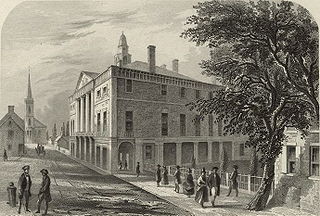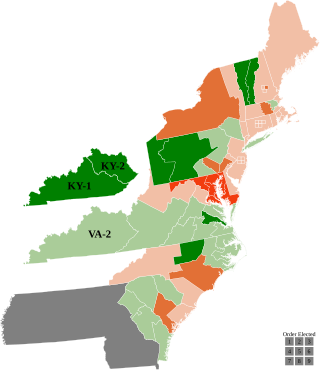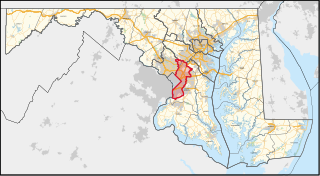Related Research Articles

The 1st United States Congress, comprising the United States Senate and the United States House of Representatives, met from March 4, 1789, to March 4, 1791, during the first two years of George Washington's presidency, first at Federal Hall in New York City and later at Congress Hall in Philadelphia. With the initial meeting of the First Congress, the United States federal government officially began operations under the new frame of government established by the 1787 Constitution. The apportionment of seats in the House of Representatives was based on the provisions of Article I, Section 2, Clause 3, of the Constitution. Both chambers had a Pro-Administration majority. Twelve articles of amendment to the Constitution were passed by this Congress and sent to the states for ratification; the ten ratified as additions to the Constitution on December 15, 1791, are collectively known as the Bill of Rights, with an additional amendment ratified more than two centuries later to become the Twenty-seventh Amendment to the United States Constitution.

The 1792–93 United States House of Representatives elections were held on various dates in various states between August 27, 1792, and September 6, 1793. Each state set its own date for its elections to the House of Representatives before the first session of the 3rd United States Congress convened on December 2, 1793. With the addition of the new state of Kentucky's representatives, and the congressional reapportionment based on the 1790 United States census, the size of the House increased to 105 seats.

The 1790–91 United States House of Representatives elections were held on various dates in various states between April 27, 1790, and October 11, 1791. Each state set its own date for its elections to the House of Representatives before or after the first session of the 2nd United States Congress convened on October 24, 1791. This was the first midterm election cycle, which took place in the middle of President George Washington's first term. The size of the House increased to 67 seats after the new state of Vermont elected its first representatives.

The 1788–89 United States House of Representatives elections were the first U.S. House of Representatives elections following the adoption of the Constitution of the United States. Each state set its own date for its congressional elections, ranging from November 24, 1788, to March 5, 1789, before or after the first session of the 1st United States Congress convened on March 4, 1789. They coincided with the election of George Washington as the first president of the United States.

Maryland's 7th congressional district of the United States House of Representatives encompasses almost the entire city of Baltimore and some of Baltimore County. The district was created following the census of 1790, which gave Maryland one additional representative in the House. It was abolished in 1843 but was restored in 1950 as a west Baltimore district. It has been drawn as a majority-African American district since 1973. Democrat Kweisi Mfume is the current representative, winning a special election on April 28, 2020, to finish the term of Elijah Cummings, who died in October 2019. Mfume had previously held the seat from 1987 to 1996.

Maryland's 4th congressional district wraps around the eastern edge of Washington, D.C., taking in most of Prince George's County and a small portion of Montgomery County. It is home to several racially diverse middle-class suburbs, including College Park, Fort Washington, Greenbelt, and Laurel. With a median household income of $86,941, it is the wealthiest black-majority district in the United States.

The 1790–91 United States Senate elections were held on various dates in various states. These U.S. Senate elections occurred during the first midterm election cycle, which took place in the middle of President George Washington's first term. As these elections were prior to the ratification of the Seventeenth Amendment in 1913, senators were chosen by state legislatures. Senators were elected over a wide range of time throughout 1790 and 1791, and a seat may have been filled months late or remained vacant due to legislative deadlock. In these elections, terms were up for the nine senators in Class 1.

The 1790 United States House of Representatives elections in New York were held from April 27 to 29, 1790, to elect six U.S. Representatives to represent the State of New York in the United States House of Representatives.

The 1793 United States House of Representatives elections in New York were held in January 1793, to elect 10 U.S. Representatives to represent the State of New York in the United States House of Representatives.

Elections to the United States House of Representatives were held in Pennsylvania on October 9, 1798, for the 6th Congress.

Connecticut elected all five of its representatives at-large on a general ticket on September 20, 1790.
Elections for the United States House of Representatives for the 2nd Congress were held in Massachusetts beginning October 4, 1790, with subsequent elections held in four districts due to a majority not being achieved on the first ballot.

The 1793 Pennsylvania gubernatorial election occurred on October 8, 1793. Incumbent Democratic-Republican governor Thomas Mifflin sought re-election to another term, defeating Federalist candidate and U.S. Representative Frederick Muhlenberg. Muhlenberg won only two counties: York and Bedford. However, Mifflin's 2-1 vote margin was down from his 10-1 victory margin in the 1790 gubernatorial election.

The 1790 Pennsylvania gubernatorial election was the first gubernatorial election after the establishment of the Commonwealth of Pennsylvania as a U.S. state. Thomas Mifflin, the incumbent President of the Supreme Executive Council of the Commonwealth of Pennsylvania was elected as the first Governor of Pennsylvania. He defeated Federalist candidate Arthur St. Clair, former Revolutionary War general and President of the Continental Congress, by a wide margin.

A special election was held in Connecticut's at-large congressional district on December 16, 1790 to fill a vacancy left when Representative-elect Pierpont Edwards (P) declined to serve.

A special election was held in New York's 1st congressional district April 26–28, 1791 to fill a vacancy left by the death of Representative-elect James Townsend (P) on May 24, 1790, before the first meeting of the 2nd Congress

The 1792 United States elections elected the members of the 3rd United States Congress. Congress was broadly divided between a Pro-Administration faction supporting the policies of George Washington's administration and an Anti-Administration faction opposed to those policies. Due to this, the Federalist Party and the Democratic-Republican Party were starting to emerge as the distinct political parties of the First Party System. In this election, the Pro-Administration faction maintained control of the Senate, but lost its majority in the House.

The 1790 United States elections were the first U.S. midterm elections. They occurred in the middle of President George Washington's first term, and determined the members of the 2nd United States Congress. Formal political parties did not exist, but Congress was broadly divided between a faction supporting the policies of the Washington administration and a faction opposed to those policies. Despite modest gains for the anti-administration faction, the pro-administration faction retained control of both houses of Congress. Vermont and Kentucky joined the union during the 2nd Congress.
References
- 1 2 "First Congress membership roster" (PDF). Archived from the original (PDF) on December 5, 2014. Retrieved January 17, 2015.
- ↑ A New Nation Votes